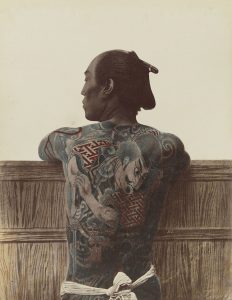Traditional Techniques from Around the World
Tebori Tattoo — Japan
The Japanese traditional version of stick-and-poke consists of using a wooden or metal stick knowns as a ‘nomi’. It has a set of needles — sometimes up to 15! — attached with silk thread to its tip. The artist would have several sets of sticks with varying numbers of needles and blades to fill in and shade the easily recognisable traditional Japanese motives.
The technique dates back to the Edo period when the Irezumi style of tattoo was just beginning to take shape. Irezumi literally means ‘inserting ink’ and it requires a special ink called ‘nara’. The artist who performs them is called a Horishi and usually has one or two apprentices working for them over a long period of time. 
Skin Stitch — North America
Along the Pacific Coast of Northwest America, the practice of tattooing among indigenous people was done by a method called ‘skin stitching’. It basically involves soaking a thread in ink, and then stitching it through the skin on a needle. The thread would then be removed, leaving behind only a tattoo in the shape of the stitches. Traditionally, the needle would be made from slivers of bone, and the thread would be made of sinew from whale or caribou.
Handtap Tatau
Polynesians have been tattooing for over 2000 years. The name for the Polynesian practice has become synonymous with other techniques, and what we have dubbed even the modern gun-slinging buzzing variety for it.
Writing did not exist in Polynesian culture, and so the markings would serve to communicate social status, sexual maturity, ancestry and rank. Given the hierarchical nature of Polynesian society, this meant that nearly everyone was inked. Sometimes the traditional tattoos would tell entire stories.
Ta Moko — Samoa
The traditional method of the South Pacific Maori is based on an ancient tattooing technique that uses a chisel and a hammer to set the ‘ink’ made from ash to the skin. The artist would create cuts in the skin with a chisel made from bone, and then fill those cuts with the ash to draw distinctive lines.
To receive a moko tattoo was a moment of transition into adulthood, and its design would have a spiritual meaning. Men were expected to undergo up to three to four months of inking as a rite of passage. The process would last for entire days, and the healing process was just as long.

Bamboo Tattoo
This Thai method is done with a long rod (traditionally made form bamboo, now more often metal) with a sharp point at the end. The technique is considered to have originated during the Khmer period. It began to spread with Buddhist temples across Asia. Monks would receive text tattoos from grandmasters for blessings and protection. These traditional tattoos are known as ‘sak yant’ and are considered holy.
Today you could get a sak yant tattoo from many different tattoo studios in Thailand, but traditionally they are done by a monk or an ‘ajarn’, a master who has studied sak yant traditional tattoos and the spirituality connected to them.
Until we can all travel about freely again, lets be thankful for the internet and all the history and inspiration that is available right at our fingertips. There was never a better time to dream up your next tattoo.
